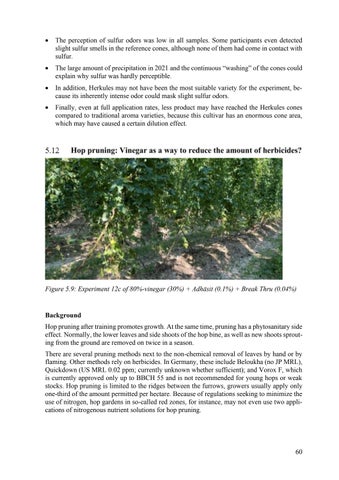•
The perception of sulfur odors was low in all samples. Some participants even detected slight sulfur smells in the reference cones, although none of them had come in contact with sulfur.
•
The large amount of precipitation in 2021 and the continuous “washing” of the cones could explain why sulfur was hardly perceptible.
•
In addition, Herkules may not have been the most suitable variety for the experiment, because its inherently intense odor could mask slight sulfur odors.
•
Finally, even at full application rates, less product may have reached the Herkules cones compared to traditional aroma varieties, because this cultivar has an enormous cone area, which may have caused a certain dilution effect.
Figure 5.9: Experiment 12c of 80%-vinegar (30%) + Adhäsit (0.1%) + Break Thru (0.04%)
Background Hop pruning after training promotes growth. At the same time, pruning has a phytosanitary side effect. Normally, the lower leaves and side shoots of the hop bine, as well as new shoots sprouting from the ground are removed on twice in a season. There are several pruning methods next to the non-chemical removal of leaves by hand or by flaming. Other methods rely on herbicides. In Germany, these include Beloukha (no JP MRL), Quickdown (US MRL 0.02 ppm; currently unknown whether sufficient); and Vorox F, which is currently approved only up to BBCH 55 and is not recommended for young hops or weak stocks. Hop pruning is limited to the ridges between the furrows, growers usually apply only one-third of the amount permitted per hectare. Because of regulations seeking to minimize the use of nitrogen, hop gardens in so-called red zones, for instance, may not even use two applications of nitrogenous nutrient solutions for hop pruning.
60













